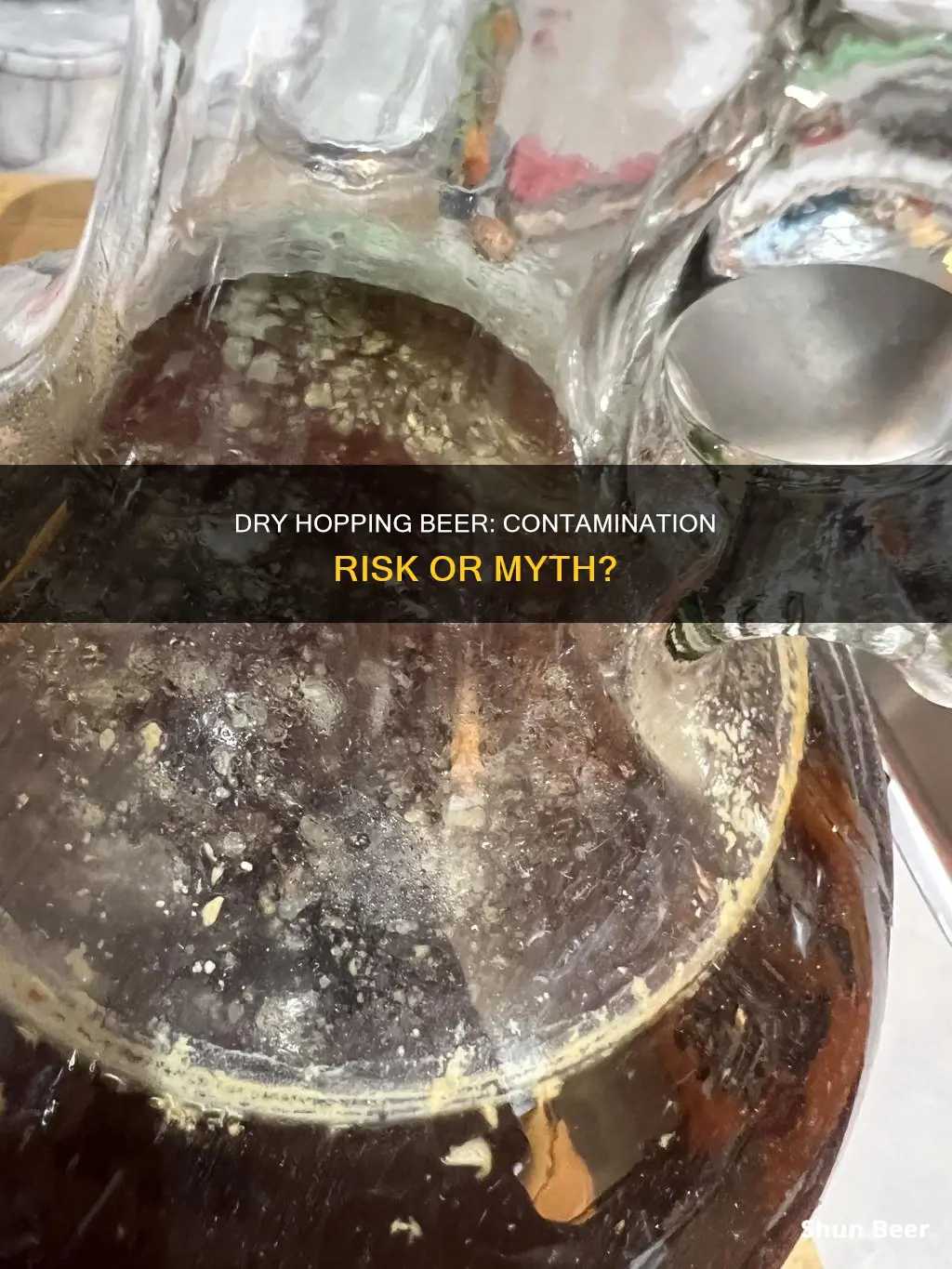
Dry hopping is a popular technique in brewing that involves adding hops to the beer late in the brewing process, either during fermentation or conditioning. It is used to infuse the beer with more hoppy aromatics and enhance its flavour. While hops are antibacterial and help prevent beer spoilage, they can, in some cases, introduce bacteria into the beer from other brewing equipment during dry hopping.
Hops themselves are not antiseptic or sterile, and some bacteria can live on them. However, the alcohol present in the beer after primary fermentation will protect it against bacteria. The risk of contamination is further reduced if good manufacturing practices are followed.
| Characteristics | Values |
|---|---|
| Hops antibacterial properties | Hops secrete iso-alpha-acids which attack the membrane of bacteria cells and make it impossible for them to take in nutrients. |
| Hops as bacteria transport | Hops can transport bacteria into fermented beer from other brewing equipment during dry hopping. |
| Beer antibacterial properties | Beer contains alcohol and has a low pH, making it a hostile environment for most strains of bacteria. |
| Contamination prevention | Sanitise the hops bag and any equipment that will come into contact with the hops. |
What You'll Learn

Hops' antibacterial properties
Hops have been used for centuries to preserve beer and are known for their antibacterial properties. The antibacterial properties of hops are due to the presence of bitter acids, specifically iso-alpha-acids, which are produced from alpha acids during the boiling process. Iso-alpha-acids affect the cell membranes of Gram-positive bacteria, making it impossible for them to take in nutrients. This property of hops essentially kills off bacteria by disrupting the pH gradient and preventing multiplication.
The antibacterial properties of hops have been well-documented, particularly against Gram-positive bacteria such as Lactobacillus, Streptococcus, Staphylococcus, Listeria, Clostridium, and Bacillus species. Hops also exhibit antibacterial activity against some Gram-negative bacteria, including Helicobacter pylori and Brucella species.
In addition to their antibacterial properties, hops also possess antifungal activity against certain fungal species, such as Fusarium, Botrytis, and Mucor. The antimicrobial effects of hops are attributed to the presence of prenylated phenolic compounds, including bitter acids, chalcones, and flavanones.
The antibacterial properties of hops make them an excellent natural preservative in beer. However, it is important to note that hops themselves can transport bacteria from other brewing equipment during dry hopping, which can potentially contaminate the beer. Proper sanitation of equipment and the use of sanitized hop bags can help reduce the risk of contamination during dry hopping.
Hops' Preservative Powers: Keeping Beer Fresh
You may want to see also

Sanitising the hops bag
Understanding the Risk of Contamination
Firstly, it is important to understand that hops themselves are excellent at combating bacteria in beer due to their chemical makeup, particularly the secretion of iso-alpha-acids. However, hops can still transport bacteria into fermented beer from other brewing equipment during dry hopping. This contamination can occur even if the hops are not bagged, but using an unsanitised bag can introduce additional bacteria.
Sterilising the Hops Bag
To sanitise the hops bag effectively, it is recommended to boil the bag in water. The high temperatures achieved through boiling will kill off most unwanted bacteria. Ensure that you boil not only the bag but also any accessories you plan to use, such as weights or dental floss for tying the bag.
Alternative Sanitising Methods
While boiling is the most recommended method, some brewers suggest using no-rinse sanitisers like Star San. To use this product, dilute it properly (0.4 oz/6 ml per gallon) and spray it on the bag. However, this method may not penetrate deep into the material of the bag, so boiling is generally preferred.
Timing of Sanitisation
The timing of sanitising the hops bag is also important. Ensure you sanitise the bag just before adding the hops and using it, as sanitising too far in advance could allow bacteria to build up again.
Sanitising Other Equipment
Don't forget to sanitise other equipment that will come into contact with your hops and beer, such as worktops, surfaces, and the outside of the fermenter. Use no-rinse sanitisers or boiling water to effectively clean these surfaces and reduce the risk of contamination.
Handling the Hops
When handling the hops, it is a good practice to scrub your hands with soap and water beforehand to minimise the risk of transferring bacteria. Additionally, consider the timing of adding the hops; adding them during the secondary fermentation when most of the sugars are gone, the alcohol level is high, and there is a lot of dissolved CO2 creates a less hospitable environment for bacteria.
Other Tips
Some brewers choose to steam the hops briefly before adding them to the fermenter, but this is not a necessary step as the alcohol present after primary fermentation should protect against bacteria. Additionally, consider using pellets over whole leaf hops, as they are easier to separate from the beer and have better accessibility to aromatic oils due to the production process.
In summary, sanitising the hops bag and other equipment is a crucial step in the dry hopping process to prevent unwanted bacteria from contaminating your beer. By following the steps outlined above, you can effectively sanitise your equipment and create a safe and delicious brew.
Where to Find Tropical Hop Beer Near You
You may want to see also

The role of alcohol in protecting the beer
Alcohol plays a crucial role in protecting beer from bacterial contamination, particularly during the dry-hopping process. Dry hopping involves adding hops to the beer after fermentation, and since the hops are not boiled, there are concerns about introducing bacteria. However, the alcohol present in the fermented beer acts as a safeguard.
Alcohol is a byproduct of the fermentation process, where yeast metabolizes grain-derived sugars into alcohol and carbon dioxide. The alcohol content in beer typically ranges from 3% to 15%, with an average of around 4% to 5%. While the primary purpose of alcohol in beer is not preservation, it has a protective function.
The alcohol content in fermented beer creates an environment hostile to most strains of bacteria. The combination of alcohol, yeast dominance, and low nutrient availability for bacteria makes it challenging for them to survive and multiply. This protective effect of alcohol is particularly relevant in the context of dry hopping, where hops are added to the beer without being boiled first.
During dry hopping, hops can potentially introduce bacteria into the beer from other brewing equipment. However, the alcohol present in the fermented beer suppresses bacterial growth. The alcohol content, along with the low pH of the beer, inhibits bacterial activity. This is why bacterial contaminations caused by dry hopping are extremely rare, as mentioned by experienced brewers.
Additionally, hops themselves possess antibacterial properties. Hops secrete iso-alpha-acids, which specifically target Gram-positive bacteria, including lactic acid bacteria that can cause beer spoilage. These iso-alpha-acids attack the membrane of bacteria cells, preventing them from absorbing nutrients, ultimately leading to their death.
In summary, alcohol plays a vital role in protecting beer from bacterial contamination. The alcohol content in fermented beer, combined with the antibacterial properties of hops, creates an unfavourable environment for bacteria. This safeguard is especially important during the dry-hopping process, where hops are added without boiling, ensuring that the final beer remains safe for consumption.
Hops Beer: The Secret Behind the Bitter Buzz
You may want to see also

The risk of bacterial contamination
Dry hopping is a technique used in brewing to add hops to the beer during the secondary fermentation stage of the process. This technique is used to add a burst of hop aroma to the beer, with desirable pine, grapefruit, citrus, or floral aromas, depending on the hop variety used.
The likelihood of bacterial contamination is further reduced by the fact that fermented beer is not an ideal environment for most strains of bacteria to grow due to the presence of yeast and alcohol. Additionally, the low pH and lack of nutrients in fermented beer create a hostile environment for bacterial growth.
To minimize the risk of bacterial contamination during dry hopping, it is recommended to sanitize any equipment that will come into contact with the hops, including worktops, surfaces, and the outside of the fermenter. Sanitizing the hop bag, if one is used, is also crucial to prevent the introduction of bacteria.
While bacterial contamination is a valid concern, the antibacterial properties of hops, the hostile environment of fermented beer, and proper sanitation practices significantly reduce the risk of contamination during dry hopping.
Grow Your Own Hops for Beer: A Step-by-Step Guide
You may want to see also

The impact of dry-hopping on beer bitterness
Dry-hopping is the process of adding hops to the wort on the cold side of the brewing process. It is used to extract as many of the hop essential oils as possible, which are largely lost during the standard hopping process. Dry-hopping can be done in the primary or secondary fermenter, or by adding hops directly to a keg.
The type of hops used for dry-hopping also matters. Hops with high alpha-acid ratings will generally increase bitterness, whereas "aroma hops" with low alpha-acid ratings will contribute less bitterness and more flavour and aroma. The amount of hops used will also affect bitterness, with larger amounts generally leading to more bitterness.
Additionally, the time and temperature of the dry-hopping process can influence bitterness. Longer durations and higher temperatures generally lead to greater extraction of bitter compounds. However, very long dry-hopping times may lead to the extraction of plant matter, resulting in grassy or vegetal aromas.
Finally, the form of the hops (whole, pellet, or plug) can also impact bitterness. Pellet hops are more highly processed and may lose some volatile oils, so slightly more may be needed to achieve the desired bitterness.
Hops Toxicity in Dogs: Beer Hops' Harmful Effects
You may want to see also
Frequently asked questions
Dry hopping is a technique used in brewing to add hops to the beer during the fermentation or conditioning phase of the brewing process. It is done to add more aroma and flavour to the beer.
Hops have antibacterial properties and are good at combating bacteria in beer. However, hops can transport bacteria into fermented beer from other brewing equipment during dry hopping.
To prevent contamination, hops bags can be boiled to kill any unwanted bacteria. It is also a good idea to clean and sanitise any equipment that will come into contact with the hops before introducing them to the fermenter.







